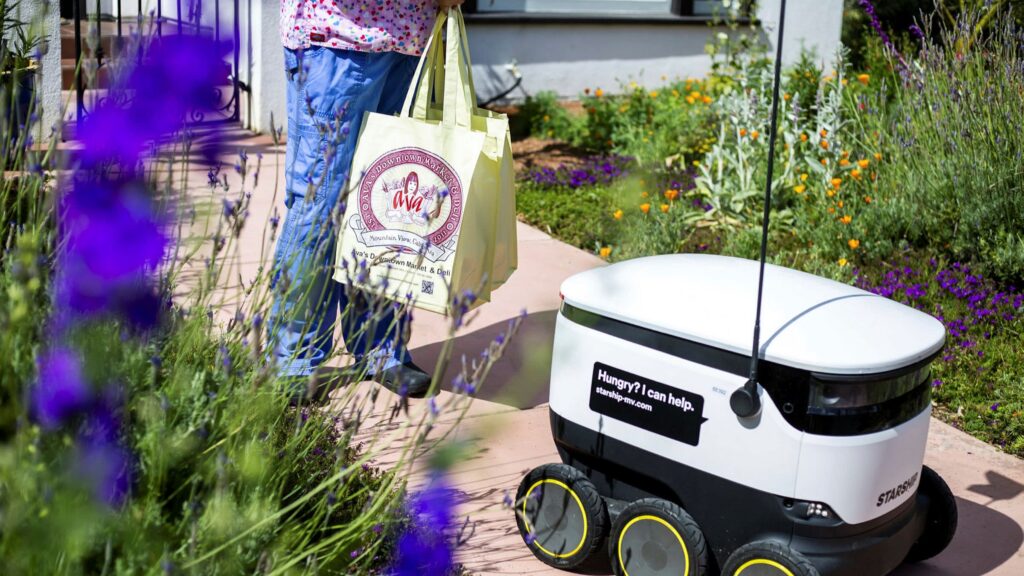The robots are coming for Deliveroo’s riders


When Ocado, the UK technology group, unveiled its vision for the future of grocery home delivery last week, it sounded a little alarming. “An autonomous robot will get out of [an] autonomous vehicle, will collect your groceries, and hand them to you at the doorstep,” an executive promised the BBC.
Well, thanks for the offer. But I prefer to stick with the friendly people who turn up at our door with the weekly shopping and wish us a happy weekend, rather than being confronted by a robot clutching all the bags. Apart from their physical dexterity, sentient beings are better at conversation.
I would feel less regret about robots edging out moped delivery riders for meal services such as Deliveroo and Uber Eats, who weave through traffic in London and other cities, invade bicycle zones at junctions and sometimes jump the lights. A trundling fleet of robots might be gentler and safer.
It is wrong to place all the blame on riders with learner plates who are often rushing to fulfil enough orders on commission to earn a basic living. Most are self-employed, without the support of employers to enforce safety standards and limit the financial incentive to break speed limits. No company would let robots loose on the roads so casually.
It would also be churlish, given how much is delivered to homes by riders and drivers, particularly during the pandemic. There is no sign of a let-up in the shift to online delivery: $14bn of venture capital has been invested in ultrafast grocery delivery services such as Getir and Jiffy.
The customer clearly wants it, but the cost and complexity of home delivery pose a financial challenge: it is difficult to turn a profit and would be harder still if riders were employed on secure contracts. The drop in Deliveroo’s shares on its first day as a public company demonstrated investors’ unease about how the model operates.
So it is no wonder that these technology companies, which is how they see themselves, are looking for ways to slash one of their biggest expenses — the humans they rely on for the last mile of delivery. McKinsey, the consultancy, estimates that replacing humans with autonomous vehicles could reduce last-mile delivery costs by 40 per cent.
This has created a flurry of enthusiasm for robots that glide along pavements, or navigate roads. Ocado has invested £10m in Oxbotica, a self-driving software group, while Domino’s offers pizza delivery in Houston on vehicles operated by Nuro, a US start-up.
Machine transport of groceries is already with us, but you need to live on a campus or in a small city to experience it. Small boxlike robots operated by Starship Technologies, a US group with developers in Estonia, have wheeled around Milton Keynes at a stately 4mph since 2018, carrying a couple of bags per trip.
Robots will not knock on doors for some time. Jeff Bezos, Amazon’s founder, predicted in 2013 that drones could start delivering packages within five years. But the company only gained Federal Aviation Administration approval to test a US drone fleet in August. In practice, fully autonomous delivery is tricky.
Nuro’s R2 autonomous vehicles, which resemble miniature Volkswagen camper vans, have been tested on minor roads in three US states, but cannot use multi-lane highways. Most delivery robots would be stymied by the complexities of a modern metropolis — their natural habitat is a suburb with wide pavements and quiet junctions.
It still feels more like an experiment than a mass technology: today’s machines are travelling containers, with customers lifting out their orders on arrival. Amazon is testing its own Scout robots in the US but they are accompanied by “Amazon Scout Ambassadors”, like the men with red flags who walked in front of 19th-century motor cars to warn of their approach.
This leaves some time to ponder whether we really want robots to replace humans for local delivery. Those involved offer rosy visions of potential benefits: a report by the consultancy Steer for Nuro says that the US could create 3.4m jobs a year, save 4,800 lives over a decade from car crashes and reduce carbon dioxide emissions.
Those promised jobs are in retail and logistics, as well as vehicle and software engineering. But I wonder about that. Robots are already at work in Amazon warehouses, and Ocado’s short-term goal is to use its partnership with Oxbotica to bring more automation to its own fulfilment centres. The entire delivery chain is under scrutiny.
Whatever the quality of delivery rider jobs, a lot of people want them: Deliveroo says it received 16,000 rider applications a week in the UK during the fourth quarter of last year. For some young men (London’s delivery mopeds are mostly ridden by them) there are not many higher paid alternatives.
Still, low margins and self-employed contracts tell a story: the delivery rider will be an endangered species as soon as machines can perform the transport element of the task. There will be a place for supervisors, ambassadors and doorstep greeters, but robots will be right behind them.